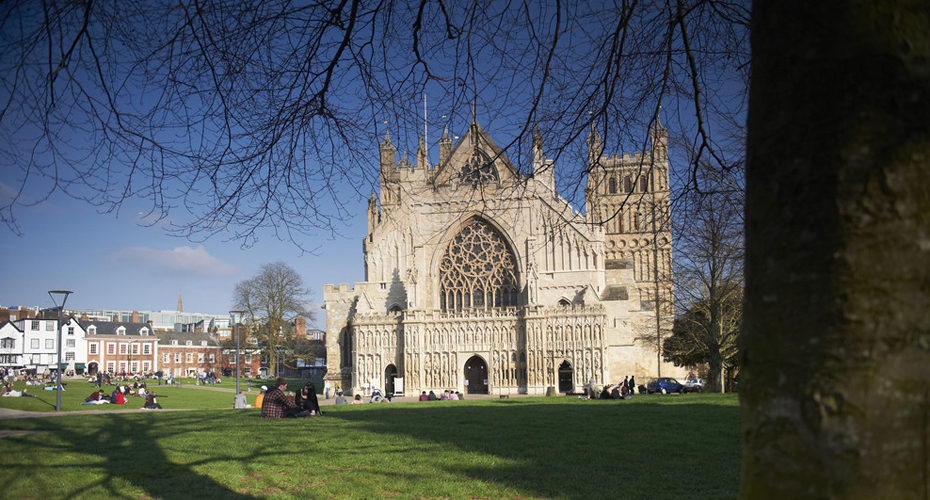Places of note
In Exeter you’re never more than a few steps away from a reminder of the city’s diverse and exciting past. With its Roman origins, gothic cathedral and legacy of the Blitz, Exeter has a mix of ancient and modern architecture to explore.
Roman origins
Originating as a Roman fort, Exeter has one of the longest and most distinguished histories of any British city. Around 70 per cent of the 2000-year-old Roman wall that once surrounded the city still stands today. Take in the rich history with a walk around the City Wall Trail.
Rougemont Castle
Rougemont Castle, founded for William the Conqueror in 1068, was built in the northern corner of the Roman city walls on a knoll known as red hill, hence the name ‘Rougemont’. The Castle is mentioned in Shakespeare's Richard III in reference to Richard’s visit to Exeter in 1483. Devon's county court was also located here from at least 1607 and the ‘Bideford Witches’ (the last people in England to be executed for witchcraft) were also tried here in 1682. Today the Castle is a hub of art, music, food and drink, and hosts a number of events throughout the year.
St Nicholas' Priory
St Nicholas' Priory was a Benedictine Monastery founded in 1087 after the Norman conquest of England. This historic building played a substantial role in the development of the medieval city of Exeter.
After the dissolution of the monasteries under Henry VIII in 1536, the church, chapter house, dormitory and cloisters were demolished. The domestic buildings survived and later became the Tudor home of a wealthy merchant family. Still furnished as an Elizabethan town house, the priory has been used as a museum since 1916.
Exeter Cathedral
Located right at the heart of the city centre is Exeter Cathedral. With its imposing gothic architecture, impressive vaulted ceiling, astronomical clock and stunning stained-glass windows, the Cathedral is a must-see. It is also home to the Exeter Book, or Codex Exoniensis, which is a 10th-century collection of Anglo-Saxon poetry. The surrounding Cathedral Green is a popular spot amongst students, locals and visitors to enjoy the sunshine.
Underground passages
Running under the city are the medieval underground passages. Dating from the 14th century, the passages were built to bring in clean drinking water from natural springs just outside the city walls. Today you can take a guided tour of these narrow passages in an experience unique to Exeter.
City guided tours
Exeter’s Red Coat Guides offer free guided walking tours of the city, perfect for those looking to explore further. Find out more about their exciting tour options.
The Guildhall
The magnificent Guildhall building, in the very centre of town, is purportedly the oldest municipal building still in use in the country and has been the centre of Exeter’s civic life for more than 800 years. A building of outstanding architectural interest, it’s been a Grade I listed building since 1953 and is also a scheduled ancient monument, highlighting its national importance.
Gandy Street
Gandy Street is one of Exeter’s most eclectic and picturesque streets. The narrow, cobbled lane is filled with colourful boutiques, bars and restaurants. Find this hidden gem just off the High Street and explore its unique offerings day or night.
Princesshay
Princesshay is a shopping precinct in the centre of Exeter. It originally opened in the 1950s to replace the buildings that had been damaged during World War II, one of which can still be seen in situ today. Princesshay has subsequently been rebuilt and opened as a new shopping centre in 2007. With over 60 retailers and restaurants, you can find both big high-street brands and unique independent stores here.
One of the most attractive areas of the city, Exeter’s Quayside is popular with locals, students and visitors alike. A 10-minute walk from the city centre, it has a fascinating history, beautiful architecture, lively pubs and restaurants, and a cluster of antique shops. A multitude of events happen on the River Exe throughout the summer, including dragon boat racing, open air concerts, markets, street food, charity events and art exhibitions. The Quay is also a launchpad for accessing National Cycle Route 2 which stretches down both sides of the Exe Estuary, to Exmouth and Dawlish beaches.
The Exeter Ship Canal was built in the 1560s, making it one of the oldest artificial waterways in the UK. Today many people hire canoes and kayaks to explore Exeter’s historic canal. Enjoy the calm waters and beautiful scenery before taking a pitstop at the Double Locks or the Turf Locks, two student-friendly pubs, for a drink or bite to eat. If you don’t fancy paddling yourself, you can take a scenic boat cruise with Exeter Cruises. Cruises normally take place at weekends between Easter and September, and daily from mid-July to August.
Exeter Science Park is paving the way for leading science and laboratory research, as well as boosting the regional economy. Located at the gateway to the Exeter and East Devon Growth Point, Exeter Science Park occupies the perfect location with immediate access to major road and rail networks along with Exeter Airport.
With considerable scientific resources on the doorstep, including the Met Office and the University, companies located on the Park benefit from the strong networks that have been built up regionally, nationally and internationally.
On fine sunny days the people of Exeter head to the quay. Cobbled paths lead between former warehouses that have been converted into antique shops, quirky stores, craft workshops, restaurants and pubs (popular spots for al fresco drinks and people-watching).

